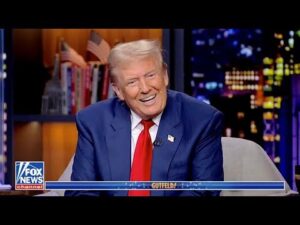Fresh Jobs Report to Offer Snapshot of US Economy Under Trump 2025
Introduction
A fresh jobs report is set to provide new insights into the US economy under Donald Trump’s presidency. Employment numbers serve as a crucial measure of economic performance, impacting policy decisions, business confidence, and the general well-being of Americans. This article dives into the latest job report and examines how Trump’s policies shaped the employment landscape in detail.
Understanding the US Jobs Report
What Is the Jobs Report?
The jobs report, officially known as the Employment Situation Summary, is a crucial economic indicator released monthly by the Bureau of Labor Statistics (BLS). It

provides comprehensive data on employment trends, including job creation, unemployment rates, and wage growth. This data is widely used by policymakers, investors, and businesses to assess the health of the economy.
The jobs report includes several key components:
- Nonfarm Payroll Employment: Tracks the number of jobs added or lost in various sectors, excluding farming jobs.
- Unemployment Rate: The percentage of people actively seeking jobs but unable to find work.
- Labor Force Participation Rate: Measures the proportion of the working-age population that is either employed or actively looking for work.
- Wage Growth: Evaluates the average earnings of workers, reflecting income stability and purchasing power.
Why Is the Jobs Report Important?
The jobs report is essential because employment data influences economic policy and financial markets. A strong report, indicating job growth and low unemployment, boosts consumer confidence and stock market performance. Conversely, weak employment numbers may signal an economic downturn, leading to policy interventions such as interest rate cuts or stimulus measures.
Trump’s Economic Policies and Their Impact on Employment
Tax Cuts and Their Effect on Job Creation
One of Trump’s landmark policies was the Tax Cuts and Jobs Act of 2017, aimed at reducing corporate taxes to stimulate economic growth. The tax cuts lowered the corporate tax rate from 35% to 21%, allowing businesses to retain more profits.
Positive Impact:
- Increased business investment and expansion

Fresh Jobs Report to Offer Snapshot of US Economy Under Trump - Higher hiring rates as companies reinvested savings
- Wage increases due to lower tax burdens on corporations
Negative Impact:
- National debt increased due to reduced tax revenue
- Wealth inequality widened as benefits skewed toward higher earners
Deregulation and Business Growth
Trump’s administration focused heavily on deregulation, removing or relaxing federal rules in industries like energy, finance, and manufacturing. The goal was to reduce the burden on businesses and encourage economic growth.
Benefits:
- Lower costs for businesses, encouraging job creation
- Faster approval processes for construction and energy projects
- Increased competitiveness in global markets
Challenges:
- Environmental and consumer protections weakened
- Potential long-term consequences of reduced oversight
Trade Policies and Their Consequences
Trump’s trade policies were a mixed bag, featuring protectionist measures such as tariffs on imports from China and renegotiation of NAFTA, which led to the United States-Mexico-Canada Agreement (USMCA).
Positive Effects:
- Protection of American manufacturing jobs

Fresh Jobs Report to Offer Snapshot of US Economy Under Trump - Encouragement of domestic production
Negative Effects:
- Higher costs for businesses reliant on imports
- Trade wars led to job losses in agriculture and retail
Trends in Employment Under Trump
Job Growth Over the Years
During Trump’s presidency, the US experienced steady job growth before the COVID-19 pandemic. Between 2017 and early 2020, over 6 million jobs were added. However, the pandemic caused massive layoffs, bringing the unemployment rate to historic highs.
Unemployment Rate Trends
Before the pandemic, the unemployment rate hit a 50-year low of 3.5% in late 2019. However, COVID-19 caused it to spike to 14.8% in April 2020, marking one of the worst economic downturns in modern history.
Wage Growth and Labor Participation
Despite job growth, wage increases remained moderate. The labor force participation rate also stagnated, meaning that fewer Americans were actively seeking work compared to previous decades.
Sectors Benefiting from Trump’s Policies
Manufacturing and Blue-Collar Jobs
Trump prioritized the revival of manufacturing, promising to bring back jobs outsourced to foreign countries. While there were some gains, automation continued to pose a challenge.
Technology and Innovation Sector
The tech industry flourished during Trump’s term, benefiting from deregulation and market expansion. However, restrictive immigration policies affected the hiring of skilled foreign workers.
Small Businesses and Entrepreneurship
Lower taxes and reduced regulations helped small businesses grow. However, the COVID-19 pandemic severely impacted many small enterprises, leading to closures and layoffs.
Challenges and Concerns in the Job Market
Impact of Trade Wars on Employment
Tariffs on Chinese goods led to higher costs for American manufacturers and retailers, affecting job stability in sectors reliant on imports.

The Gig Economy and Job Stability
The gig economy expanded significantly under Trump, with more people working as freelancers or contract employees. While this provided flexibility, it also raised concerns about job security and benefits.
Automation and the Future of Work
Automation and artificial intelligence threatened traditional jobs in manufacturing and service industries, requiring workforce retraining and skill development programs.
The Bigger Economic Picture
Stock Market Performance and Investor Confidence
The stock market reached record highs under Trump, fueled by tax cuts and deregulation. However, market volatility increased during trade wars and the pandemic.
GDP Growth and Economic Expansion
The US economy expanded steadily until the COVID-19 crisis. Growth slowed in 2020, prompting government stimulus measures.
Inflation and Consumer Spending
Inflation remained low during most of Trump’s presidency, but rising costs in healthcare and housing affected middle-class Americans.
Comparing Trump’s Job Numbers to Previous Administrations
Trump’s job creation figures were strong pre-pandemic but did not significantly outperform Obama’s final years. The COVID-19 crisis disrupted employment trends, making direct comparisons complex.
Conclusion
The fresh jobs report provides a mixed snapshot of the US economy under Trump. While his policies contributed to job growth, challenges like trade wars, automation, and the pandemic reshaped employment trends. His economic legacy will be debated for years to come.
FAQs
- How accurate is the US jobs report?
- The jobs report is based on surveys but can be revised later as more data comes in.
- Did Trump’s policies help reduce unemployment?
- Yes, pre-pandemic unemployment hit a 50-year low, but COVID-19 led to job losses.
- What industries saw the most job growth under Trump?
- Manufacturing, technology, and small businesses benefited the most.
- How does job creation impact the overall economy?
- More jobs lead to higher consumer spending, boosting economic growth.
- What factors influence employment trends the most?
- Policies, technological advancements, global trade, and economic cycles all play a role.
Share this content:






1 comment